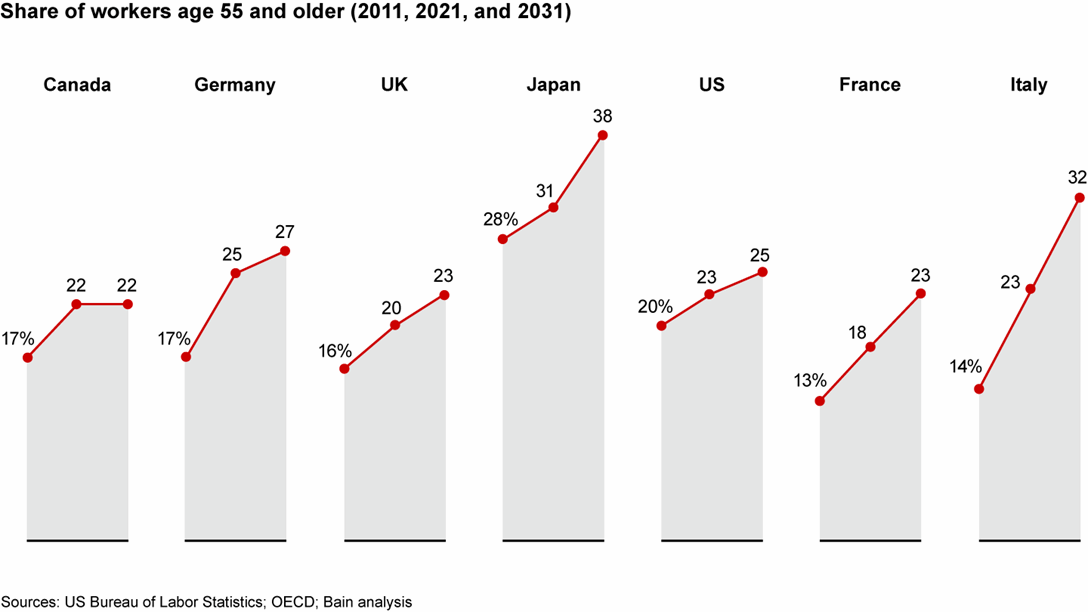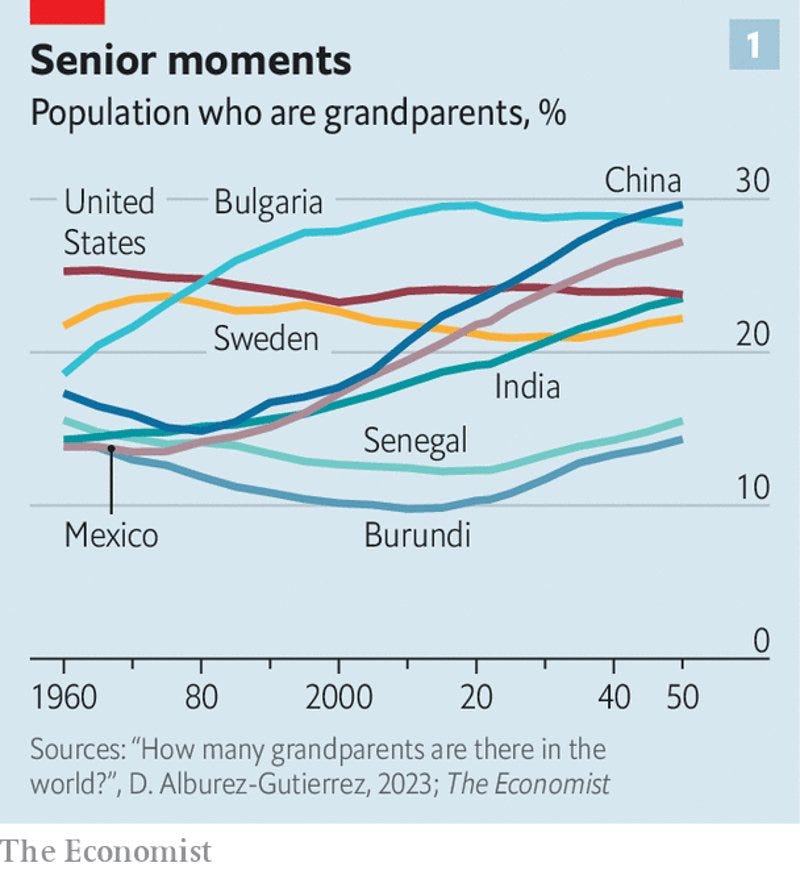Living Better, not Just Longer: Reinventing Work for the Silver Workforce
#WF54 – Adapting to demographic changes including Singapore's midlife reskilling, China's 300m retirees, and, Grandternity leave.
Today is the oldest you’ve ever been, and the youngest you’ll ever be again.
Eleanor Roosevelt
We are living longer, healthier lives.
Women in France, Italy, and Japan can expect to live past 86 years.
In the average 20th-Century life model we study for 20 years, work for 45 years - until the state or your employer tells you to stop, we do something called ‘retire’ and then we die 14 years later.
This article is about how employers and countries are adapting to the gradually shifting demographics.
We are working longer, yet why are many UK older workers leaving the workforce? Will China get rich before it gets old? What is Singapore doing to help its workforce reskill? what is ‘grandternity leave’, and the million-dollar question, how can we live better? I also pose some Questions on adaptation for Workforce Futurists.
This article lazily uses averages to explain - make sure you are on the right side of the average.
(This article is also available as a Podcast🎙️)
Of a Pensionable Age
"Old age hath yet his honour and his toil." Alfred Lord Tennyson (1809-1892)
A Brazilian man, Walter Orthmann, has been working at the same textile company for more than eight decades. (Source - Guinness Book of Records)
There have been changes since Walter started working in 1938. From cubicles to emails, and remote working - but how we view work is similar.
Since the 1960s, life expectancy has increased by 4 or 5 years in developed countries.
We are living longer, and working later.
The average retirement age in OECD countries is 65 and creeping up slowly with varying levels of resistance. France’s proposal to increase the retirement age from 62 to 64 was met with riots followed by discussions over a fine meal.
As life expectancy and retirement ages increase, so the life-expectancy-after-pensionable-age has grown to 22 years for women, and 17 for men.
The future of work is as diverse as the 3.5 billion individuals in the global workforce, presenting a kaleidoscope of possibilities. It’s much more than just the people who work for multinationals in Memphis, Manchester, and Malmö.
Taking a global view, only 68% of people of retirement age receive some form of pension and in some low-income countries, this drops to 20%.
So dear reader, tell me, when do you expect to stop working, when you are 100 like Walter, or….
The Silver Worker Wave
In the graph, you will see a prediction that older workers will exceed a quarter of the 2031 workforce in Japan, Germany, the US, and Italy.
41% of American workers expect to work beyond 65, thirty years ago this expectation was 12%.
Despite this aging shift organisations don’t seem to spend enough focus on integrating older workers into the work system, there is more focus on the TikTok generation.
For employers, there are major skills shortages across sectors and it is harder to retain and hire workers with the right skills. The cost of living is high, and older workers still have a lot to give. With some creativity and innovation (see examples below) a focus on older workers can pay off. However, to increase the success of any workforce initiatives it is worth examining why some workers are leaving the workforce, for example in the UK…
Why Have Older UK Workers Left the Workforce?
The UK has witnessed a concerning increase in economic inactivity among the 50 to 64 age group since the pandemic. This is 650,000 individuals who are not unemployed, and not actively looking for employment.
The reasons Why are complex. Official data indicates that sickness, injury, or disability is cited as the main reason for economic inactivity among 43% of adults aged 50 to 64, compared to 31% citing retirement in 2023.
(this tweet thread caught my eye).
We are not fully managing the long-term impact of COVID on society or the workforce.
You can read more about this in my article - Navigating the Fourth Wave of the Pandemic.
With 1 million job vacancies in the UK, productivity dips. National efforts to encourage people back to work include cutting inheritance tax (in carrot and stick terminology, I guess this is the stick) and a stated aim to increase the labour force by 300,000.
The UK government is emphasising the importance of healthcare improvements and cultural shifts within firms to accommodate older workers.
From Europe to Asia, we have different challenges…
Getting Old Before Getting Rich – China’s Demographic Challenges
300 million Chinese people will retire by the end of the decade.
Why do Chinese grandparents matter to the Western workforce?
Since the 1980s, about 600 million Chinese joined the global workforce. The ‘Elephant 🐘 curve of global inequality’ is a visual representation that ranks the world’s citizens on income, and you can read more about it here. It shows that while wages in the West peaked in the 1980s and have slowly declined since then, the rise of China's middle class has contributed to a significant reduction in global inequality.
China’s demographic challenges, including falling births, fast aging, a pension crisis, a workforce shortage as 217 million people are aged over 65. Women working in blue-collar jobs can retire at 50.
The World’s second-largest economy is seeing an unprecedented era of ‘getting old before getting rich’.
Central bank adviser Cai Fang has set his sights on the so-called silver economy to turn the crisis into development opportunities. This includes calling for elevating the welfare of the elderly and boosting the high-quality supply of services, from caring to digital inclusiveness.
As the workforce ages, what are other countries doing to prepare people and support employers?
Singapore’s SkillsFuture Solution for the Over 40s
In Singapore, the SkillsFuture program exemplifies a government-led initiative aimed at supporting mid-career workers in acquiring new skills.
By providing subsidies and opportunities for individuals aged 40 and above to pursue full-time diplomas and higher education, the program acknowledges the need for continuous learning and adaptation in a rapidly changing economic landscape.
This forward-thinking approach aligns with the rapidly changing technological landscape, encouraging mid-career workers to learn new skills alongside their younger counterparts.
Singapore is innovative in workforce matters, issuing verifiable blockchain wallets to its cohort of new graduates.
Granny Demographics and Delayed Nesting
There are 1.5 billion grandparents in the world today, this is up from 0.5 billion in 1960.
With more grandparents, great grandparents, and grandaunts and uncles, there are more Easter Eggs, babysitting options, and financial handouts.
How does this impact the workforce?
Working later is one factor, but also supporting multiple-generation family members in the workforce. When babysitting duties are over, the age at which young adults leave their family nest varies globally.
In Sweden, the little chicks🐤 leave early, with an average departure age of 17.8 years, this compares to Portugal where the departure age is 33.6 years.
Factors like housing costs, dating status, career prospects, and fondness for home-cooked meals play a role. It is estimated it now takes 13 years to save a deposit to buy a house in the UK, which was 3 years in the 1990s.
This delay in achieving financial independence is impacting career decisions and employer propositions.
How Employers are Adapting to the Silver Workforce
The most important factor in survival is neither intelligence nor strength but adaptability. Charles Darwin
Adaptability is the core survival trait for modern organisations.
There is no single template for work design. It includes recognising the diverse needs and capabilities of the workforce and designing inclusive policies and programs.
Firstly strip out bias and discrimination in all HR processes, or initiatives like the ones below will fail.
Not all jobs are the same. In China for women there is a 5 year difference in retirement age for white-collar and blue-collar work. Working in a factory in your seventies is not as feasible as working part-time in a shop.
Employers have set up programmes with specific goals to adapt to workforce demographics. Here are some examples,
‘Grandternity leave’ - some companies now offer paid leave for grandparents, allowing employees time to bond with their new grandchildren. E.g. Mercer Australia and New Zealand
It is estimated that 5% of American companies with more than 500 staff offer egg freezing as a benefit to female workers. This is an example of employers encouraging workers to commit their most fertile (and productive) years to their employer. These companies include Deloitte, LinkedIn, Intel, eBay, Netflix, Salesforce, Spotify, and Time Warner.
Microsoft and the NBA offer menopause benefits to keep women in the workforce, including hormone therapy and counselling.
Unilever offer a programme called U-Work that allows staff to leave full-time employment while staying on a retainer, with staff benefits including a pension and private healthcare.
Unilever also offers support for employees with caring responsibilities by sourcing at-home carers and residential home placements.
Mitsubishi Corp. established a Career Design Center exclusively for employees aged 60 and older, offering custom training, job matching, and individual consultation services.
Questions on Age Adaptation for Workforce Futurists
So with better health, longer working, and multi-generational workforces – what are the questions we need to ask to adapt smartly in the next few years?
1. How should we reformulate the concept of work to embrace more diversity in expectations, flexibility, and contract structures?
2. What needs to happen to increase opportunities for the employment of older individuals like the energetic 73-year-old who wants part-time work without undue administrative burdens?
3. How does the traditional notion of retirement need to adapt to a much greater range of working contracts, freelancers, solopreneurs etc. What other mechanisms can be considered to offer alternative forms of financial security that are not based on traditional employment? As explored in the discourse on ‘building a better world without jobs’ - good quality jobs for everyone anyway…
4. Drawing inspiration from Singapore's emphasis on lifelong learning, how can governments fund reskilling initiatives to equip individuals with the necessary skills to adapt to evolving job markets and technological advancements?
5. Considering the shifting attitudes toward property ownership among the 18-34 age group, how does this influence employer offerings and career aspirations?
6. What are the implications of demographic trends, such as delayed independence and increased intergenerational collaboration, for workforce mobility, innovation, and inequality, and how can we foster a more inclusive and dynamic labour market in response?
I’m interested in examples where your organisation, city, or you have developed solutions to the ageing workforce - whether young and ripe, or old and fresh.
Make sure you are subscribed to hit reply and comments.
Living Better, Not Just Longer
“but one loses, as one grows older, something of the lightness of one’s dreams; one begins to take life up in both hands, and to care more for the fruit than the flower, and that is no great loss perhaps.” W.B. Yeats
As we ponder the implications of increased longevity, its worth considering that it’s a privilege to get older. The goal is not just to live longer but to live better.
Bronnie Ware, worked as a nurse in palliative care, and wrote a book "The Top Five Regrets of the Dying".
One major regret cited was,
"I wish I hadn't worked so hard."
An appropriate message to close an article about the future of work.
By embracing age diversity and reimagining work in light of changing demographics, we can create a future where individuals of all ages thrive.
Please share your views in the comments.
This one is for my parents 🙏









Interesting that life expectancies in the US can change so much depending on what region someone is living in so I wonder what differences in trends we might observe in those areas